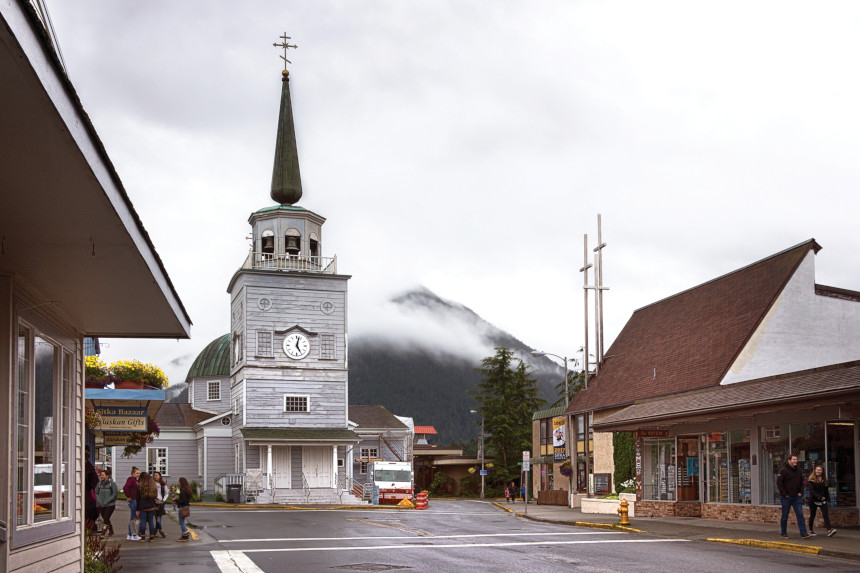Touching Alaska
When you’re in grizzly country, it’s a good idea to give the hosts a heads-up when paying a visit. Don’t want any awkward moments. So, after our two eight-person skiffs make land, before we even get to the woods, our guides are already shouting “Whoop-whoop!” I join in with “Hey, bears!” feeling the need to make the callout a bit less threatening. After all, it is their territory.
Bushwhacking (rugged hiking without a trail through mud and dense undergrowth, as we’re doing now) is one of several options for passengers on an UnCruise Adventure. There are also plenty of moderate activities, such as kayaking, paddle-boarding, and touring the coastline in small crafts. UnCruise, with its fleet of small (76- to 90-passenger) ships, prides itself on being an alternative to the mega-cruisers that ply the waters of Southeast Alaska. On the big ships, you get an overview of the state’s magnificent wilderness. On the UnCruise, you step into it.
Our voyage began in Sitka, on remote Baranof Island in Southeast Alaska, and would conclude in Juneau. Partly to acclimate to the time zone and partly just to spend a little time on dry land before shipping out, my wife Estelle and I hunkered down on Sitka four days prior to our departure. That’s highly recommended, since Sitka, in its own way, gives you a feel for the remoteness and beauty of Alaska (see sidebar, page 56).
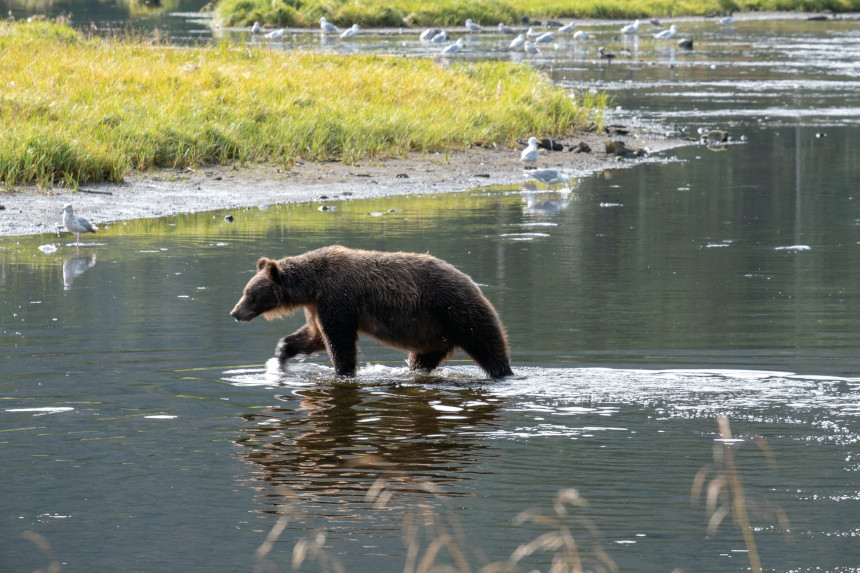
Thanks to all the shouting, we seem to be alone on the shore, but signs of animal activity abound. We stop to study tracks left by deer, wolves, bears. “Still warm!” says our guide excitedly as she hovers her hand inches above some bear scat.
At first it seems impossible to find a way into the woods from the beach thanks to the thick undergrowth at the forest’s edge. But after several false starts, slogging through mud in our knee-high rubber boots, we find a suitable opening, punching through alder and gently pushing aside thorny devil’s club. This leads us first into a cathedral-like conifer forest of Sitka spruce, mountain hemlock, and yellow cedar. There are mosses and lichens underfoot, and thickets of blueberry.
We press on. Suddenly a small, black, cat-like creature pops up in front of us. It’s a marten (of the weasel family). It’s not clear who’s more startled, us or the marten. It freezes, does a double take, then zing! Off it darts, disappearing into the undergrowth.
I wonder if we might surprise a bear in the same way — wishing (just a little) that we will. As the joke goes, you don’t have to run fast if you come across a bear in the wild. Just faster than the next person.
Deeper we go into the dark forest, climbing over fallen logs, pulling ourselves up steep embankments using tree branches for support, when suddenly we come to a large clearing of dense grasses and wildflowers. This, expedition guide Bobby DeMarinis explains, is a muskeg marsh, which forms in low flat areas with poor water drainage. “The water collects and saturates the soil,” he says. “Then oxygen levels decrease in the soil, which also becomes very acidic as needles from conifer trees decompose.”
Spruces and hemlocks tend to die off in these areas, and the result is what looks like a meadow in the middle of the woods. But it’s not like any meadow you’ve ever known. The ground is spongy, the grass thick and deep. DeMarinis identifies the wildflowers as we walk among them — labrador tea, round leaf sundew (a small, delicate flycatcher), shooting stars (featuring beautiful backward-facing petals), and more.
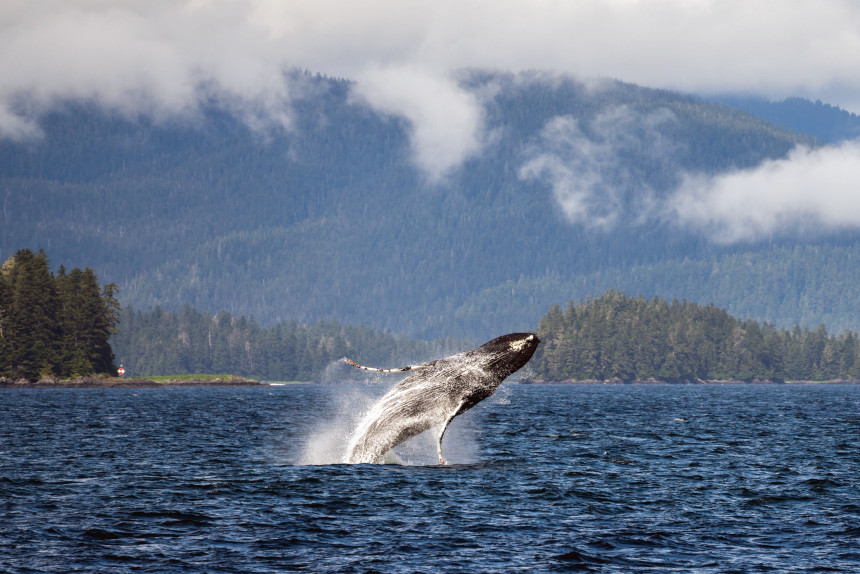
Our ship spends much of each day at anchor. In the evening and at night, it moves along, the gentle rocking ensuring good sleep. Late one afternoon, Estelle and I push off in a kayak from the portable dock lashed to the back of the ship. We paddle softly through placid black water, bald eagles soaring above us, mountains in the distance. For a while, we stop in the middle of the bay, listening to the wind, the birdsong. Suddenly a harbor seal pops up alongside, giving us the once over. Just as suddenly, it disappears.
Between the day’s many options for activities, there are lectures on wildlife, on Alaskan history, on early explorers to the region. But the schedule frequently changes and the ship will stop or change course for sightings of humpback whales, killer whales, seals sunbathing on rocky outcroppings, wild goats, and birds of all kinds. It’s all very freewheeling, and one becomes accustomed to changes in plans.
One morning as we drop anchor, a bear is spotted in the high grasses along the shore. Everyone reaches for binoculars, but a few minutes later, the decision is made to pull up anchor and find a different landing point — too dangerous to land near a bear patrolling its territory. All the day’s planned activities are pushed back as we find another anchorage about an hour away.
That flexibility is typical of the UnCruise experience. As Tim Voss, the captain of our ship, the SS Legacy,
explains, “We may not cover a lot of ground, but we take our time and focus on the wilderness and on shore. We’ll stop to study a plant or an animal on the beach. It’s what we do, and we’re passionate about allowing passengers to really feel the places they visit. We want them to say, ‘I came to Alaska but I actually put my boots in the mud. I smelled the forest and walked in it.’”
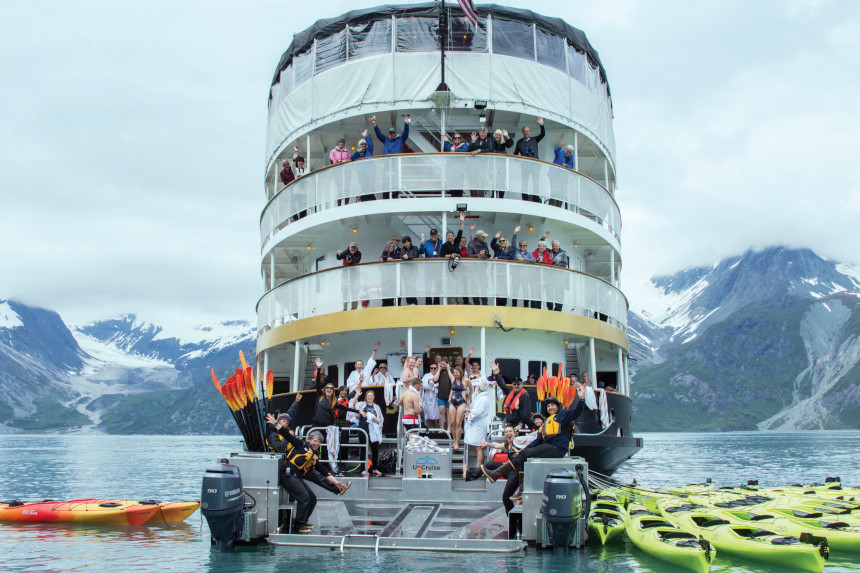
Several days in, while sailing through Glacier Bay, the highlight of many Alaskan cruises, we anchor near the majestic Margerie Glacier. There, not more than 100 yards from the ice, some of us participate in “the polar plunge,” a dive off the aft deck into 40-degree water, followed in my case by an extremely fast exit.
Later in the day, a small group debarks for a hike up a steep rocky outcropping alongside the glacier. From our vantage point, sitting on rocks amid lovely blue and white wildflowers, we spot a pod of three killer whales — two parents and a juvenile — on the hunt. Soon, a large cruise ship pulls into the bay and circles past the glacier. As it departs, we wave at the crowds lining the deck high above the water, capturing the stunning vistas on their phones and video cameras. And we feel privileged that for a short while we’ve been more than just observers of Alaska’s wildest and most beautiful places — we’ve actually touched and experienced them.
If you go: The per-person cost for a one-week UnCruise Adventure ranges from $3,000 to about $7,500. The fee includes delicious food and beverages, including alcohol. (Cocktail hour is a pleasant respite after a day of outdoor activities.) Discounts are available on some trips booked by mid-December. Two other excellent small-ship options with similar amenities and routes are Alaskan Dream Cruises and Lindblad Expeditions.
Steven Slon is the Post’s editorial director.
Featured image: UnCruise passengers hiking above Glacier Bay. (UnCruise)
This article is featured in the September/October 2019 issue of The Saturday Evening Post. Subscribe to the magazine for more art, inspiring stories, fiction, humor, and features from our archives.
Post Travels: North Pole, Alaska
One would expect the North Pole is a busy place this time of year. But truth be told, it’s Christmas every day of the year in North Pole, Alaska. Less than a 20 minute drive from Fairbanks, the city is known for its holiday spirit. Street lights look like giant candy canes and assorted buildings sport Christmas colors and patterns. The Santa Claus House boasts a nearly 50-foot Santa Claus statue and walls covered with letters to Santa. As this video shows, even streets have names like Santa Claus Lane and St. Nicholas Drive.
See more Post Travels.
Post Travels: Chase the Northern Lights in Fairbanks
Seeing the northern lights, also known as the aurora borealis, is something many folks dream about. But freezing temperatures, long airplane flights, remote locations, and predicting Mother Nature’s whim can put a damper on even the most enthusiastic travelers’ plans.
But what many don’t realize is that one of the best locations for viewing the northern lights is located in the United States. Aurora Season runs from August 21 through April 21 in Fairbanks, Alaska, meaning there are plenty of nights you can watch the lights dance through the sky when there’s no snow on the ground.
A Taste of Alaska Lodge
Just a 20-minute drive from Fairbanks, family-owned and operated A Taste of Alaska Lodge offers easy access to the city, while still boasting a remote location that makes you feel as though you’ve ventured into the Alaskan wild. Set on 280 acres, on clear days it serves up brag-worthy views of the Alaska Range. Once the sun sets, it’s an ideal location to watch the northern lights blaze through the sky. And with only eight rooms in the main lodge, and three separate cabin-like structures on the property, you practically have the sky to yourself.

The best spot to view the aurora borealis is from an open field behind the lodge. Chairs are scattered about for folks to relax while waiting for the lights to appear. A heated yurt provides a spot to warm up and socialize with fellow watchers. Guests that head back to their room often find it difficult to venture out again. Rates from $195.
Borealis Basecamp

One look at Borealis Basecamp, and it’s hard not to get excited. Six white domes each boast a wall made of windows, precisely positioned so you can curl up in bed while watching the northern lights. Set on nearly 100 acres of boreal forest, domes have king beds, a kitchenette with small refrigerator and sink, and a bathroom with sink, stall shower, and dry flush toilet. Powerful heaters keep domes toasty, but keep your shoes by the door. It’s next to impossible not to run outside when the aurora appears. Borealis Basecamp is about a 45-minute drive from Fairbanks. Rates from $339. A two-night minimum stay is required. (Four more domes are currently under construction.)
Chena Hot Springs Resort

A bit more than 60 miles outside of Fairbanks, Chena Hot Springs Resort requires the longest stretch of time behind the wheel, but there’s plenty of incentive to make the drive. As the name implies, natural hot springs averaging 106 degrees Fahrenheit are open for soaking daily from 7 a.m. to midnight. Even during summer, guests searching for an Alaskan chill can visit the onsite Aurora Ice Museum. Kept at a cool 25 degrees Fahrenheit, it’s home to a handful of rarely used guest rooms, sculptures, and a bar that pours strong Appletinis. Those hoping to see the northern lights can make the short walk to the property’s heated Aurorium or book a tour to a remote spot near Charlie Dome that boats panoramic nighttime sky views. A heated yurt is well-stocked with warm drinks and snacks. The bumpy ride up to the viewing point, in the back compartment of a unique off-road vehicle, helps keep travelers awake and alert. Eighty rooms with rates from $210.
North Country Girl: Chapter 19 — Duluth Dentists Gone Wild
For more about Gay Haubner’s life in the North Country, read the other chapters in her serialized memoir. The Post will publish a new segment each week.
My dad would shake his head over the Cs on my report card from gym and home ec, ignoring the As in math, history, science, and English (Bs in Spanish); did he not know who I was? I had always excelled at anything that required brain power; ask my fingers or legs or arms to do something, and I was as helpless as an earthworm.
My grades were good enough that my parents had no compunctions about pulling me out of seventh grade for a week. A dental convention in Mexico City was the tax-deductible impetus for a tour through Acapulco, Taxco, and Cuernavaca. My dad thought the exposure to a foreign culture would be good for me. Heidi was not yet two, and Lani, as usual, was the middle child afterthought: they got left at home with the sitter. I, the smart one, the lucky one, the anointed, flew south with my parents and grandparents.
My father’s favorite thing was to travel without hotel reservations. I was not on the trip to the New York City where my parents had to spend the night in a second-floor walk-up hotel in Harlem, back when Harlem was Harlem. I was on the family skiing trip in Wisconsin over a holiday weekend, when we drove for hours in the dark, passing one neon NO VACANCY sign after another. In the middle of the night we finally stopped at a hunting lodge that had closed for the season, but whose owners had stayed on. By a miracle this lovely old couple were awake and felt sorry enough for the exhausted-looking family to let us spend the night in one of the unheated cabins. They even made us breakfast.
This, however, was an American Dental Association trip, which meant fancy hotels, bus tours, and meals at restaurants where the most Mexican item on the menu was a margarita. In Acapulco my parents and I were given a luxury two-bedroom suite at the El Presidente hotel, as evidently the roll away bed had not yet been introduced to Mexico. Floor to ceiling windows looked out over the famously beautiful Acapulco Bay, a vision I thrilled to again while watching the first season of I Spy, and then, eight years later, from the balcony of a high-rise condo, while making out with a playboy from Chicago who was twenty-two years older than me.
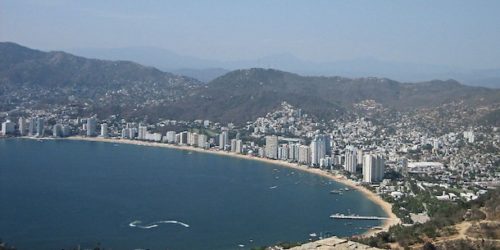
My first day in Acapulco I was pulled sputtering and floundering out of a fierce undertow by a sharp-eyed dentist while my own dad was getting drunk at the bar. Heavy drinking Minnesota dentists plus cheap Mexican booze equaled a non-stop party that started in the morning with Bloody Marias and ended when someone got hurt or sick. Dentists were jumping off roofs into pools, getting into fistfights, laughing so hard on burro rides they pissed themselves. I was the only kid in this group, and as I was small and quiet (even when drowning) I went as unnoticed as a salt shaker, even by my own family.
I finally piped up during a drunken dinner at a fancy restaurant when I saw a flaming baked Alaska cross the room and was struck that here was the height of sophistication. Cake, ice cream, meringue, and a fire! If only I had a baked Alaska of my own I could die happy. I was certain that my request would not be granted: the usual answer to “Can we have dessert?” at a restaurant alternated between concern for our teeth from my father and “We have ice cream at home” from my mother. But my dad was tipsy and in a benevolent mood and my mom was too busy worrying about what drunken dental hijinks were in store that night. I felt like a princess when the waiter set the blue-flamed baked Alaska in front of me. It was Neapolitan ice cream set on a slice of chocolate cake, surrounded by hot, sticky, marshmallow-y goo, and it was delicious.

The last day in Acapulco the dentists who were not too hungover and their wives gathered around a open space between the hotel and the beach to watch three men dressed as Aztec warriors fling themselves off a 40-foot pole, anchored by vines knotted around their ankles. While I watched agog as they twirled around the rotating pole, I overheard two dental wives discussing the night before. Little pitchers do have big ears. A taxi driver had offered to take some of the dentists and their wives to see a “show” at a whorehouse.

During the show, one of the group, in a perfect storm of drunkenness, decided to participate. But it was a not a dentist, but Mrs….here the woman’s voice dropped to a whisper, so I’ll never know which of the wives, hiding behind the cat’s eye sunglasses and under ugly straw hats purchased for way too many pesos from the voracious beach vendors, women who were sun-burned or coping with Montezuma’s revenge or hungover or all three, which of these demur ladies had ripped off her clothes and jumped on to the stage at the whorehouse and into the arms of the leading man.

Once away from the Acapulco nightlife, the dentists dried out and recuperated in Taxco and Cuernavaca, pretty colonial towns with pastel houses covered in bougainvillea, that featured boring tours of silver and pottery stores. In Taxco my father stepped off the tour bus and, instead of heading for the air-conditioned hotel for lunch, took me into the most flyblown, dingy restaurant on the plaza. We sat by the greasy front window at a table as sticky as flypaper, even though miraculously the 500 flies buzzing around our heads seemed able to resist setting down there, preferring to wait till the food arrived. As my dad was ordering the enchiladas suizas (how did he even know what that was? The only Mexican food I had seen in Duluth was in a Swanson’s Mexican Style TV dinner, where every brown component in the foil tray tasted the same), my mom and grandmom appeared at the open doorway, afraid to step inside in case germs clung to the soles of their shoes. Both moms ordered us to get out of there and not touch anything. I dutifully obeyed, but my dad just grinned and tucked into a huge platter of green and white something, while the waiter stood behind, waving off flies with a menu. My grandmother turned bilious just looking at the enchiladas; my dad finished the whole thing, burped, gave the waiter the equivalent of 90 cents, and felt absolutely fine.
My mother was not so lucky. She not only got sick from almost everything she ate, she had a terrible reaction to the smallpox vaccine the Dental Association recommended she get before traveling south of the border. She spent the night of the big formal gala at the actual convention in Mexico City puking and watching her arm swell up to the size of an elephant’s trunk. I was sent off to find my dad at the party, which was held on the top floor of our fancy hotel. He refused to leave, being several margaritas in and, never having experienced any illness himself outside of killer hangovers, didn’t believe anyone could get sick from a shot. I grabbed some food off a tray and went back to our room, my book, and the scary sounds emanating from the bathroom.
I was now a sophisticated world traveler. I had been out of the United States! I never missed an opportunity to mention my travels, until even my best friend Wendy finally asked me to shut up about Mexico. But summer camp provided a whole new audience. I embellished my travelogue for my bunkmates, giving myself a handsome 16-year old Mexican boyfriend, Andres. In this new version, it wasn’t a balding orthodontist from Edina who pulled me out of the undertow in front of the El Presidente hotel, it was Andres, who then fell instantly in love with me, a reverse Little Mermaid. I spun a tale of Andres sneaking into our suite when my parents were out; how we would make out passionately on the sofa overlooking the lights of the bay. I confessed that Andres tenderly tried to stick his hand under my shirt, but I held him in check, despite his protestations of undying love. I told and retold the story of my imaginary romance so often that I almost came to believe it myself. For the two weeks of camp, I was the most popular girl in our bunkhouse, and even the counselors looked at me as if I might be interesting.
I came back from camp that seventh grade summer, basking in my fraudulent role as resident boy expert and sadly aware that I didn’t want to go to camp anymore. What if all of those camp girls who boasted of boyfriends and their extensive knowledge of sex were just big fakers too?

I had just gotten home when Wendy called to tell me that she had overheard Rick Bryers (one of my heartthrobs) and Steve Puloski talking about me. Two boys who knew I was alive? I couldn’t imagine what they had to say. Could they possible think I was cute? Wendy in all her innocence or malice, told me “Rick told Steve he had seen you at the Northland pool” (my racing thoughts: I did look adorable in my first two-piece suit, a red and white Hawaiian floral, what was Rick Bryers doing at Northland Country Club and….HE NOTICED ME AND KNEW MY NAME) “and Steve” (who was universally despised by the entire seventh grade for many reasons, including putting Fizzies in the biology teacher’s fish tank and showing up at all of our houses trying to sell Grit magazine or packages of seeds or greeting cards) “Steve said to Rick…flat as a board, huh?” After that there was a roaring in my ears. I hung up the phone and vowed I would never go to school again.
But I did, and eighth grade followed seventh as if it were Ground Hog Day: I was the star pupil in English, math, science, and even boring Minnesota state history. I was still chosen last when sides were picked for volleyball (why couldn’t the gym teacher simply divide the class in two?) and still regularly forgot to bring my gym uniform to school. I endured a second year of being taught useless domestic skills in home ec. I forgave Wendy for squashing my dreams of true romance with Rick Bryers and spent as many weekends as I could at her weird dorm apartment. We’d flip through that month’s Seventeen magazine, debate the merits of Napoleon vs. Ilya, review every comment made to us by a boy during the past week for signs of infatuation (“When he asked me what the caf had for lunch, did he want to sit with me?”), and try to figure out what the popular girls had that we didn’t (which was, in the end, their popularity, which made everything else — their clothes, their hair styles, their manner of speaking — admirable and something to emulate). We were two glasses-wearing, violin-playing nerds, but we had each other.
